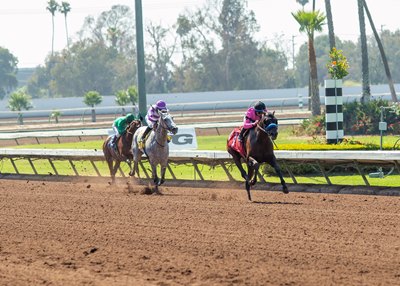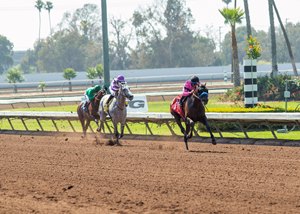CHRB Approves Los Alamitos Dates, Veterinary Rules


During a meeting of the California Horse Racing Board on April 22 by teleconference, commissioners authorized the scheduled dates for the upcoming summer meet at Los Alamitos Race Course and passed two veterinary regulations.
Los Alamitos, currently running a spectatorless meet of Quarter Horses and lower-tier Thoroughbreds in the evenings under the approval of the Orange County Health Department, is scheduled to run a six-day higher-quality afternoon meet of Thoroughbreds from June 26-July 5. It is the only Thoroughbred racing in operation in the state after Santa Anita Park and Golden Gate Fields were temporarily closed by different county health departments amid the COVID-19 pandemic.
The Stronach Group, which owns Santa Anita and Golden Gate, has requested a resumption of racing to the health departments overseeing those facilities.
The approval of dates from Los Alamitos passed unanimously among commissioners after criticism from anti-racing protesters on the teleconference, who expressed concerns that social distancing and other safety protocols were not being followed at Los Alamitos. Many of these same protesters are regular attendees of CHRB meetings, having previously opposed racing on the basis of animal welfare.
Los Alamitos officials said they were adhering to all safety procedures and had been evaluated by police and other local authorities.
Commissioners also approved a rule amendment to stipulate that a racing veterinarian is to be under the direct supervision of the official veterinarian, a move made to avoid any pressure from track employers. This rule is now subject to a 45-day comment period before it is enacted.
"No licensed official from the association can basically instruct the racing veterinarian how to do their work in their exercises or duties," explained Dr. Rick Arthur, the CHRB equine medical director. "So the bottom line is that the racing veterinarian will be independent, in terms of their professional conduct, in terms of examining horses in the light, which is what we wanted to accomplish. I do think long term that the examining and racing veterinarians need to be employees or independent contractors for the racing board, but that would have to be a long-term plan and we would have to certainly get budget changes to get that accomplished."
This regulation was made in response to an issue raised by the CHRB in its report that examined a rash of horse fatalities at Santa Anita during the early months of 2019.
After already clearing a 45-day public comment period, the board also finalized a rule calling for 30-day veterinary records for horses coming to California to compete.
"We have a relatively good history of the medications administered to the horses that are entered from within our facilities," Arthur said. "This addresses those horses that come in from outside our jurisdiction."
In other action by the CHRB, vice-chair Oscar Gonzales agreed to meet with representatives from the California Authority of Racing Fairs and The Stronach Group to solve a dispute over summer race dates for the Alameda County Fair.
The board also introduced its new executive director, Scott Chaney, who replaced the retired Rick Baedeker. Chaney reported state overall handle being down about 9%, the result of fewer race programs caused by the cessation of racing through COVID-19.
"Unfortunately, the expectation is that next month will be a good deal worse in terms of handle," he said.
Arthur told commissioners there were five necropsies from horse fatalities in March: three from racing, one from training, and one from non-exercise. He estimates that through the first three quarters of their fiscal year, they are on pace for a 25% reduction in fatalities.
"This fiscal year will have the lowest number of fatalities since the CHRB started keeping reliable fatality statistics around 1990," he said, though horses across the country are averaging fewer starts per year than decades ago.
